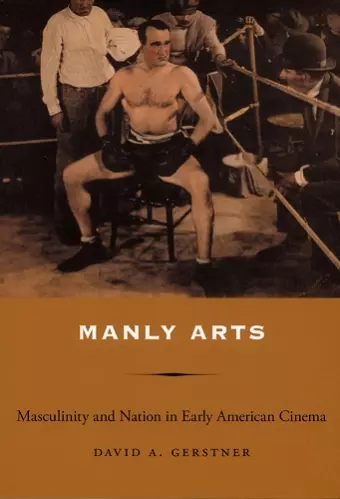Manly Arts
Masculinity and Nation in Early American Cinema
Format:Paperback
Publisher:Duke University Press
Published:6th Mar '06
Currently unavailable, and unfortunately no date known when it will be back

Describes how early-twentieth-century American filmmakers drew on a host of European and American art forms to forge a national aesthetic which equated democracy with masculinity
In this innovative analysis of the interconnections between nation and aesthetics in the United States during the late nineteenth century and the early twentieth, David A. Gerstner reveals the crucial role of early cinema in consolidating a masculine ideal under American capitalism. Gerstner describes how cinema came to be considered the art form of the New World and how its experimental qualities infused other artistic traditions (many associated with Europe—painting, literature, and even photography) with new life: brash, virile, American life. He argues that early filmmakers were as concerned with establishing cinema’s standing in relation to other art forms as they were with storytelling. Focusing on the formal dimensions of early-twentieth-century films, he describes how filmmakers drew on European and American theater, literature, and painting to forge a national aesthetic that equated democracy with masculinity.
Gerstner provides in-depth readings of several early American films, illuminating their connections to a wide range of artistic traditions and cultural developments, including dance, poetry, cubism, realism, romanticism, and urbanization. He shows how J. Stuart Blackton and Theodore Roosevelt developed The Battle Cry of Peace (1915) to disclose cinema’s nationalist possibilities during the era of the new twentieth-century urban frontier; how Paul Strand and Charles Sheeler positioned a national avant-garde through the fusion of “American Cubism” and industrialization in their film, Manhatta (1921); and how Oscar Micheaux drew on slave narratives and other African American artistic traditions as he grappled with the ideological terms of African American and white American manhood in his movie Within Our Gates (1920). Turning to Vincente Minnelli’s Cabin in the Sky (1943), Gerstner points to the emergence of an aesthetic of cultural excess that brought together white and African American cultural producers—many of them queer—and troubled the equation of national arts with masculinity.
“Manly Arts is a fascinating, meticulously researched exploration of how ideas of masculinity and aesthetics from the late nineteenth century to the 1940s produced a particularly corporealized and male ‘American’ modern art and ‘artist.’ David A. Gerstner brings movements in theater, art, literature, photography, and dance to bear on a variety of cinematic works. His canvas is broad, illuminating, and exciting in its theoretical premises and unexpected historical juxtapositions. A provocative—and major—contribution to multidisciplinary studies in the humanities and arts.”—Vivian Sobchack, author of Carnal Thoughts: Embodiment and Moving Image Culture
“Through a consideration of such seemingly disparate figures as Edwin Forrest, Theodore Roosevelt, Oscar Micheaux, Paul Strand, and Vincente Minnelli, David A. Gerstner subtly and cogently outlines the complex ways that literature, theater, cinema, and other arts created a fragile definition of nation: one predicated on white, working-class, masculine norms but also inflected by African American masculinities and queer subjectivities. Original and innovative, Manly Arts is sure to be a significant and lasting contribution to the fields of gender studies, film studies, and American arts and aesthetics.”—Paula J. Massood, author of Black City Cinema: African American Urban Experiences in Film
ISBN: 9780822337638
Dimensions: unknown
Weight: 494g
336 pages